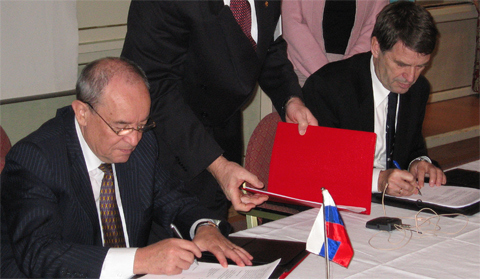Agreement on Norwegian-Russian quotas for 2007
Historisk arkiv
Publisert under: Regjeringen Stoltenberg II
Utgiver: Fiskeri- og kystdepartementet
Pressemelding | Dato: 04.11.2006 | Sist oppdatert: 12.11.2006
Implementing measures to stop illegal fishing in the Barents Sea was the main topic at the 35 th> session of the Joint Norwegian-Russian Fisheries Commission. - The Fisheries Commission has decided to give priority to this work this year as well. Norway and Russia agreed on a number of measures last year, and much has been achieved. “This year focus has been on speeding up implementation of these measures,” says Minister of Fisheries and Coastal Affairs Helga Pedersen.
Press release
No.: 93/2006
Date: 04.11.06
Contact:
Secretary General Mr. Jørn Krog, mobile +47 900 24 447
Senior Adviser Halvard Wensel, mobile +47 971 80 784
Agreement on Norwegian-Russian quotas for 2007
Implementing measures to stop illegal fishing in the
Barents Sea was the main topic at the 35
th> session of the Joint Norwegian-Russian Fisheries
Commission.
- The Fisheries Commission has decided to give priority to
this work this year as well. Norway and Russia agreed on a number
of measures last year, and much has been achieved. “This year focus
has been on speeding up implementation of these measures,” says
Minister of Fisheries and Coastal Affairs Helga Pedersen.
Norway and Russia have set a quota for Norwegian Arctic cod in 2007 at 424,000 tonnes. The quota for coastal cod has been set at 21,000 tonnes. This means that the combined total quota for Norwegian Arctic cod and coastal cod has been set at 445,000 tonnes, i.e. a reduction of 47,000 tonnes compared to the current year.
“I appreciate that the determination of quotas for joint stocks is based on the Fisheries Commission’s exploitation strategy,” says the Minister for Fisheries and Coastal Affairs.
The purposes of the strategy are to safeguard the sustainable exploitation of stocks and provide a sensible stability in exploitation from year to year by ensuring that quotas do not vary by more than 10% from one year to another.

The agreement was signed in Tromsø on Friday 3 November 2006,
following a week-long meeting of the Joint Norwegian-Russian
Fisheries Commission.
The total quota for cod is divided between Norway, Russia and third countries in the same proportions as previous years. This provides Norway with a total quota of 199,500 tonnes for next year, including 8,000 tonnes for research and management purposes, marking a 20,200 tonne reduction compared to 2006.
The haddock stock is in good condition, and the total quota has been increased from 120,000 tonnes in 2006 to 150,000 tonnes in 2007. The Norwegian quota is 76,050 tonnes after the transfer of quotas from Russia, i.e. 14,250 tonnes more than in 2006.
The Norwegian quota of king crab for 2007 has been set at 300,000 crabs. The quota has been kept at the same level as the current year. This has been determined unilaterally by Norway, and was communicated to the Russian party during the 35 th> session of the Joint Norwegian-Russian Fisheries Commission. Russian fisheries authorities have determined its quota to 3,180,000 crabs. Norway and Russia further agree to manage the crabs separately within their respective economic zones. Joint research on king crabs will still be performed and results will be presented at the Commission meetings.
”In anticipation of the report to the Norwegian parliament (Stortinget) concerning king crabs that the government will present to Stortinget next year, I have decided to continue this year’s quota level next year. Stortinget’s discussion of the report may result in changes to the Norwegian quota for 2007,” says Minister of Fisheries and Coastal Affairs Helga Pedersen.
The capelin stock is subject to large natural fluctuations in size and is still at a low level. It has therefore been decided not to allow any capelin fishing in 2007, in keeping with the agreed exploitation strategy.
The stock situation for deepwater redfish is still at a level that gives reasons to be concerned. It is therefore out of the question to allow direct fishing of deepwater redfish in 2007.
Norway has allocated secondary catch quotas of 2000 tonnes of redfish and 15,000 tonnes of saithe to Russia in Norway’s economic zone, in addition to a quota of 2000 tonnes of wolf-fish and 3000 tonnes of other non-regulated stocks. Norway has also allocated a blue whiting quota of 32,145 tonnes to Russia.
In addition to the transfer of cod and haddock quotas of 6000 and 4500 tonnes respectively, Russia has also allocated quotas of 3000 tonnes of shrimp, 1500 tonnes of wolf-fish, 1000 tonnes of flounder and 500 tonnes of non-regulated stocks to Norway. Norway can catch up to 15,000 adult seals in the Russian zone on the East Ice.
In addition to the transfer of cod and haddock quotas of 6000 and 4500 tonnes respectively, Russia has also allocated quotas of 3000 tonnes of shrimp, 1500 tonnes of wolf-fish, 1000 tonnes of flounder and 500 tonnes of non-regulated stocks to Norway. Norway can catch up to 15,000 adult seals in the Russian zone on the East Ice.